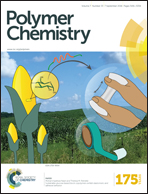Sustainable glucose-based block copolymers exhibit elastomeric and adhesive behavior†
Abstract
Herein, we present the direct modification of glucose, an abundant and inexpensive sugar molecule, to produce new sustainable and functional polymers. Glucose-6-acrylate-1,2,3,4-tetraacetate (GATA) has been synthesized and shown to provide a useful glassy component for developing an innovative family of elastomeric and adhesive materials. A series of diblock and triblock copolymers of GATA and n-butyl acrylate (n-BA) were created via Reversible Addition–Fragmentation Chain Transfer (RAFT) polymerization. Initially, poly(GATA)-b-poly(n-BA) copolymers were prepared using 4-cyano-4-[(ethylsulfanylthiocarbonyl)sulfanyl] pentanoic acid (CEP) as a chain transfer agent (CTA). These diblock copolymers demonstrated decomposition temperatures of 275 °C or greater and two glass transition temperatures (Tg) around −45 °C and 100 °C corresponding to the PnBA and PGATA domains, respectively, as measured by differential scanning calorimetry (DSC). Triblock copolymers of GATA and n-BA, with moderate dispersities (Đ = 1.15–1.29), were successfully synthesized when S,S-dibenzyl trithiocarbonate (DTC) was employed as the CTA. Poly(GATA)-b-poly(nBA)-b-poly(GATA) copolymers with 14–58 wt% GATA were prepared and demonstrated excellent thermomechanical properties (Td ≥ 279 °C). Two well-separated glass transitions near the values for homopolymers of n-BA and GATA (∼−45 °C and ∼100 °C, respectively) were measured by DSC. The triblock with 14% GATA exhibited peel adhesion of 2.31 N cm−1 (when mixed with 30 wt% tackifier) that is superior to many commercial pressure sensitive adhesives (PSAs). Use of 3,5-bis(2-dodecylthiocarbonothioylthio-1oxopropoxy)benzoic acid (BTCBA) as the CTA provided a more efficient route to copolymerize GATA and n-BA. Using BTCBA, poly(GATA)-b-poly(nBA)-b-poly(GATA) triblock copolymers containing 12–25 wt% GATA, with very narrow molar mass distributions (Đ ≤ 1.08), were prepared. The latter series of triblock copolymers showed excellent thermal stability with Td ≥ 275 °C. Only the Tg for the PnBA block was observed by DSC (∼−45 °C), however, phase-separation was confirmed by small-angle X-ray scattering (SAXS) for all of these triblock copolymers. The mechanical behavior of the polymers was investigated by tensile experiments and the triblock with 25% GATA content demonstrated moderate elastomeric properties, 573 kPa stress at break and 171% elongation. This study introduces a new family of glucose-based ABA-type copolymers and demonstrates functionality of a glucose-based feedstock for developing green polymeric materials.


 Please wait while we load your content...
Please wait while we load your content...